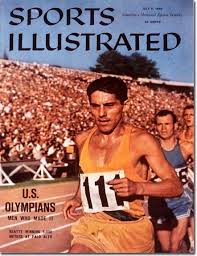Telegram
categories: Cocktail Hour
2 comments
 The following is by my friend and colleague, Wendy Brenner:
The following is by my friend and colleague, Wendy Brenner:
A couple years ago I began running into Tully Beatty everywhere, which was odd, because we’d both lived in Wilmington for more than a decade, yet since Tully graduated from UNCW’s MFA program in 2000 we had never once crossed paths. (In fact, when I first bumped into him in Harris Teeter I thought: That guy looks like Tully Beatty. I was about to apologize for staring when he turned out to actually be Tully.) Thereafter, on Facebook, I followed the cool, haunted-looking old photos and writings Tully sometimes posted about his famous father, Jim Beatty, who broke the world record for running an indoor mile in under four minutes in 1962. One image in particular captured my imagination: a grainy newspaper clipping showing three excited people holding a super-long Western Union telegram that had just been sent to Jimmy Beatty, then a 21-year-old junior at University of North Carolina, wishing him good luck in the 1956 Olympic track and field trials. The telegram was sent on behalf of more than 1200 friends and fans.
I don’t have any special interest in track and field, or the Olympics, but I knew the second I saw this photo that it was “something special” (as Martin Scorsese once said about all films made by the 1940s directing and writing team Powell & Pressburger). And then Tully told me he had in his possession the actual telegram itself, a 26-foot scroll of brittle, rapidly deteriorating paper. His dad had given it to him a few years ago. Maybe other writers – and Martin Scorsese – will understand how thrilling this was to me. I spent the next several months paying attention to the telegram, looking at it, thinking and dreaming about it, talking with Tully about it, reading all the names on it, wondering how to write about this object that mattered to me for reasons I couldn’t even articulate. The telegram is part of Tully’s life story, not mine. Having an Olympian for a father is something I know nothing about. But the desire to communicate, to make your voice span across time and space, to sign your name in favor of doing the impossible – these are longings we maybe all understand.
This fall, my short essay about the telegram came out in The Oxford American, and I received an email from filmmaker Dave Anderson, whose strange, funny, hauntingly beautiful SoLost video series for Oxford American won the National Magazine Award the first year the award was given to videos. Dave and the Oxford American editors wanted to adapt “Telegram” for the first installment of SoLit, a new video series, which is a hybrid somehow between the written word and the filmed image, and also includes music. So that is how an essay about a news clipping about a telegram became a short online multimedia film sponsored by a magazine. It is possible for two people to live in the same town for ten years and never see each other. On the other hand, the 26-foot telegram from fifty years ago reached farther than anyone – even its famous recipient or the 1200 people who sent it – could possibly have imagined.


Enjoyed this! I suspect many families, most, have their own “telegrams” – places, or objects made holy by the memory of their people. I helped my Mom move at 84, across the country to a condo near my sister and me. We unpacked her over a couple of months, some boxes pushed into corners in favor of more immediate ones. As we neared the end, some items were hadn’t been found, and she blamed the movers for losing them. We couldn’t remember if we’d lost them in the yard sale, or if they were mislabeled in the few boxes that hadn’t been opened. One item she worried over was her Father’s saw. He was a carpenter and dead for 50 years, since her early 30’s, and I had never heard of this saw until we helped unpacked her. I can’t remember if we ever located it.
Great ! Nifty & Original. Really enjoyed it.GdG.